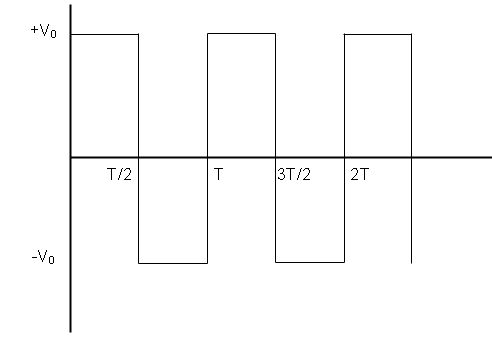
The average and RMS value of voltage for square waves shown in the fig. having a peak value ${V_0}$ are:

(A) $\dfrac{{{V_0}}}{{\sqrt 2 }},\sqrt 2 {V_0}$
(B) $\sqrt 2 {V_0},\dfrac{{{V_0}}}{{\sqrt 2 }}$
(C) ${V_0},{V_0}$
(D) Zero, ${V_0}$
Answer
224.1k+ views
Hint: In this solution, we will use the formula of average and RMS value. We only need to consider one cycle of the voltage to calculate the average and RMS value.
Complete step by step answer:
In the graph given to us, we want to calculate the average and RMS value of voltage.
The average amplitude is the mathematical “mean” of all a waveform’s points over the period of one cycle. It can be mathematically calculated as:
${V_{avg}} = \dfrac{1}{T}\int {{V_0}dt} $
We can see that the waveform of the voltage starts a cycle at $t = 0$ and ends the cycle at $t = T$. To calculate the integral of the wave function given to us, we need to break the integral down into regions where the voltage has constant values. So, we can write
${V_{avg}} = \dfrac{1}{T}\left( {\int\limits_{t = 0}^{t = T/2} {{V_0}dt + } \int\limits_{t = T/2}^{t = T} { - {V_0}dt} } \right)$
The ${V_0}$ term can be taken out of the integral since it is constant. The integral can then be simplified to
${V_{avg}} = \dfrac{{{V_0}}}{T}\left( {\dfrac{T}{2} + \dfrac{T}{2} - T} \right)$
$ \Rightarrow {V_{avg}} = 0$
Hence the average voltage will be zero.
Now, The RMS value stands for Root Mean Square value. It is a way of expressing an AC quantity of voltage or current in terms functionally equivalent to DC. It can be mathematically calculated as
${V_{RMS}} = \sqrt {\dfrac{1}{T}\int\limits_{t = 0}^T {{V^2}dt} } $
The integral can be broken into two parts as
${V_{RMS}} = \sqrt {\dfrac{1}{T}\left( {\int\limits_{t = 0}^{t = T/2} {V_0^2dt} + \int\limits_{t = T/2}^{t = T} {V_0^2dt} } \right)} $
The integral can be simplified as
${V_{RMS}} = \sqrt {\dfrac{{{V_0}^2}}{T}T} $
Or,
${V_{RMS}} = {V_0}$
Hence the correct choice is option (D).
Note: While calculating the average and the RMS value, we must not forget the $1/T$ term outside the integral. We can also find the average value graphically as zero since the area of the graph for one time period is the same in the positive and negative regime and as such, the average value will be zero.
Complete step by step answer:
In the graph given to us, we want to calculate the average and RMS value of voltage.
The average amplitude is the mathematical “mean” of all a waveform’s points over the period of one cycle. It can be mathematically calculated as:
${V_{avg}} = \dfrac{1}{T}\int {{V_0}dt} $
We can see that the waveform of the voltage starts a cycle at $t = 0$ and ends the cycle at $t = T$. To calculate the integral of the wave function given to us, we need to break the integral down into regions where the voltage has constant values. So, we can write
${V_{avg}} = \dfrac{1}{T}\left( {\int\limits_{t = 0}^{t = T/2} {{V_0}dt + } \int\limits_{t = T/2}^{t = T} { - {V_0}dt} } \right)$
The ${V_0}$ term can be taken out of the integral since it is constant. The integral can then be simplified to
${V_{avg}} = \dfrac{{{V_0}}}{T}\left( {\dfrac{T}{2} + \dfrac{T}{2} - T} \right)$
$ \Rightarrow {V_{avg}} = 0$
Hence the average voltage will be zero.
Now, The RMS value stands for Root Mean Square value. It is a way of expressing an AC quantity of voltage or current in terms functionally equivalent to DC. It can be mathematically calculated as
${V_{RMS}} = \sqrt {\dfrac{1}{T}\int\limits_{t = 0}^T {{V^2}dt} } $
The integral can be broken into two parts as
${V_{RMS}} = \sqrt {\dfrac{1}{T}\left( {\int\limits_{t = 0}^{t = T/2} {V_0^2dt} + \int\limits_{t = T/2}^{t = T} {V_0^2dt} } \right)} $
The integral can be simplified as
${V_{RMS}} = \sqrt {\dfrac{{{V_0}^2}}{T}T} $
Or,
${V_{RMS}} = {V_0}$
Hence the correct choice is option (D).
Note: While calculating the average and the RMS value, we must not forget the $1/T$ term outside the integral. We can also find the average value graphically as zero since the area of the graph for one time period is the same in the positive and negative regime and as such, the average value will be zero.
Recently Updated Pages
JEE Isolation, Preparation and Properties of Non-metals Important Concepts and Tips for Exam Preparation

Isoelectronic Definition in Chemistry: Meaning, Examples & Trends

Ionisation Energy and Ionisation Potential Explained

Iodoform Reactions - Important Concepts and Tips for JEE

Introduction to Dimensions: Understanding the Basics

Instantaneous Velocity Explained: Formula, Examples & Graphs

Trending doubts
JEE Main 2026: City Intimation Slip Releasing Today, Application Form Closed, Exam Dates, Syllabus & Eligibility

JEE Main 2026 Application Login: Direct Link, Registration, Form Fill, and Steps

Understanding the Angle of Deviation in a Prism

How to Convert a Galvanometer into an Ammeter or Voltmeter

Ideal and Non-Ideal Solutions Explained for Class 12 Chemistry

Hybridisation in Chemistry – Concept, Types & Applications

Other Pages
JEE Advanced Marks vs Ranks 2025: Understanding Category-wise Qualifying Marks and Previous Year Cut-offs

JEE Advanced 2026 - Exam Date (Released), Syllabus, Registration, Eligibility, Preparation, and More

JEE Advanced 2026 - Exam Date (Released), Syllabus, Registration, Eligibility, Preparation, and More

Dual Nature of Radiation and Matter Class 12 Physics Chapter 11 CBSE Notes - 2025-26

Understanding Electromagnetic Waves and Their Importance

Understanding Atomic Structure for Beginners




